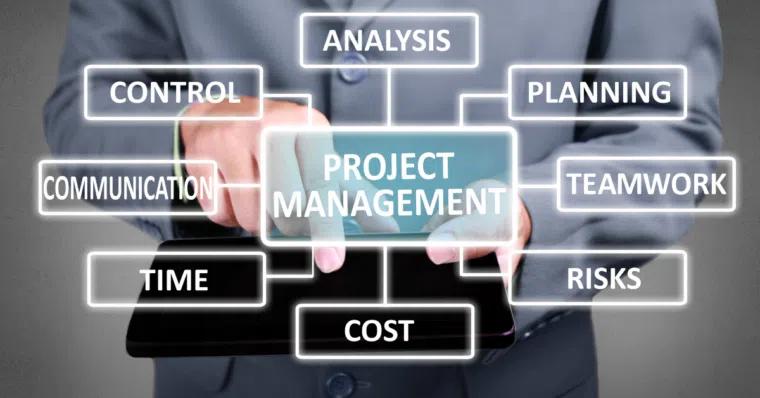Why a Risk Management Strategy Matters and How You Can Master It

According to Markets and Markets, the size of the worldwide project management market is expected to reach $6.3 billion by 2028. Clearly, then, project management has become an integral cog in a competitive business world. Today, businesses have to work to optimize their productivity and efficiency to stay ahead of the competition. In this scenario, a project manager’s role becomes even more significant. After all, without efficient planning, precise scheduling, and accurate budgeting, no business will be able to meet its growth potential. It is also important to assess possible risks a project can face in the course of its completion. Project managers, therefore, need to design an effective risk management strategy to mitigate or avoid any such risks. This helps them tackle the impact of external factors such as market changes, competition, or shifts in customer demand.
A risk management strategy, therefore, can help project managers deal with potential threats in a methodical way. Let’s take a closer look at what it means.
What is a Risk Management Strategy in Project Management?
 A risk management strategy is the proactive identification, evaluation, and timely response to potential project risks. The objective of such a strategy is to help prevent any significant hindrance to its completion. Throughout this process, regular reviews and updates about the risk assessment are conducted to ensure the strategy aligns with new information received.
A risk management strategy is the proactive identification, evaluation, and timely response to potential project risks. The objective of such a strategy is to help prevent any significant hindrance to its completion. Throughout this process, regular reviews and updates about the risk assessment are conducted to ensure the strategy aligns with new information received.
To further understand risk management, let’s look at the example of a construction company. Before a project starts, the project manager will identify all potential risks that can hinder its completion. These could be weather-related delays, the problem of resources falling short, possible last-minute requirements for additional resources, etc. The project manager would consider any and all such risks and develop a response plan, essentially a risk management strategy. This could include securing the construction site, rescheduling certain tasks, and keeping additional resources on standby to accelerate the project timeline in case of any unforeseen delays.
The manager will continuously review and revise this strategy on a regular basis in light of any new information. This strategy will be updated, if needed, depending on weather forecasts or changes in the construction plan. Therefore, by implementing this risk management strategy, the project manager can minimize the impact of any potential risks and ensure the timely completion of the project.
Types of Risk Management Strategies to Follow
There is a wide variety of risk management strategies, each of which has its own applications as mentioned below.
1. Business Experiments
This is the “what-if” model. Simply put, it means coming up with a threat that hasn’t happened but may occur. The objective is to figure out the right solution to handle the problem. This is clearly experimental in nature. By coming up with such what-if scenarios, business leaders evaluate probable outcomes of a threat that they may have to face. In most companies, IT and marketing departments run such business experiments, as do finance teams. They do so to evaluate various financial Key Performance Indicators (KPIs) or return on investments.
2. Theory Validation
Theory validation procedures make use of questionnaires and surveys to collect feedback based on real-world experience. For example, a company introduces a new product or service in the market or reintroduces an existing one with modifications made. A way to reduce the risk of the product or service failing is to gain direct, timely, and relevant feedback from end users. This helps control potential issues and design faults.
3. Isolating Identified Risks
IT teams today enlist the assistance of internal or external resources to identify deficient procedures or flaws that could expose vulnerabilities. As a result, businesses proactively detect security issues before a malicious breach even occurs. This is a significant advantage of leveraging technology to secure the business.
4. Data Analysis
Data collection and analysis are crucial to identify and manage different kinds of risks. For instance, qualitative risk analysis can be used to evaluate or discover any risks to a project. The development of methods to handle, monitor, and evaluate risks is thus easier due to such qualitative risk analysis. Managers can then find ways to pre-empt the risks, if possible, or have a plan in place if they occur.
5. Building in Buffers
Project managers are aware of the necessity to incorporate a buffer into their operations, regardless of the nature of the project. They are important fallbacks in case a project hits a roadblock. The use of buffers decreases risk and ensures that efforts do not expand beyond their original scope. Buffers as a risk management strategy can take the form of cash reserves, resource reserves, or time reserves depending on the project.
Why Should You Have a Risk Management Strategy
Project and operational risks are not uncommon for most firms. They are, in fact, a natural part of doing business; hence the need for organizations to have a risk management strategy in place. An important aspect of this is to know one’s strengths, weaknesses, opportunities, and threats, also known as doing a SWOT analysis.
A well-planned risk management strategy is important because it ensures the following:
1. Seamless Operations
Any business, no matter how successful and established, can face risks. It could be in the form of uncertainty in the market, labor problems, cyberattacks, etc. If the company doesn’t have a risk management strategy, any threat can stall operations. A cyberattack, for example, can hit the digital infrastructure of a business. Therefore, a risk management strategy should be imperative for a smoothly functioning organization. It also helps to safeguard business assets, tangible and intangible.
2. Enhanced Customer Loyalty
Businesses that think about risks and take steps to safeguard against them tend to gain the trust of customers. It conveys that you will be as proactive in ensuring your customers’ security as well. This is especially the case today, where customer data has become an integral aspect of businesses as a means to optimize service and customer experience. Knowing their data is in safe hands and secure from risk inspires trust and loyalty among customers.
3. Achieving Goals
An efficient risk management strategy is absolutely necessary when it comes to finishing projects on schedule and achieving business goals. Low or no risks mean there are no distractions or obstacles to completing a project on time. As a result, team members will be focused on the big picture.
4. Improved Profitability
Of course, completing the project on time and within budget means that the business is able to accrue the benefits of the project sooner. This could also translate into better profits. Further, the fallout of having to deal with any risks also leads to channeling resources and money into solving the problem. A risk management strategy that is able to mitigate or avoid risks implies avoiding financial losses.
ALSO READ: A Comprehensive Guide to Project Planning: The Steps That Matter
Steps to Develop a Risk Management Strategy
 These four key steps to manage risks are important to any project management plan:
These four key steps to manage risks are important to any project management plan:
1. Know the Business
Every project manager must know the state of the business in the organization. This is where the aforementioned SWOT analysis comes into the picture. Know the strengths, weak spots, and operational vulnerabilities before planning a project.
2. Identify Specific Risks
It is necessary to identify the risks that could have an impact on productivity and performance. Such risks could be financial, operational, or strategic.
3. Establish Key Risk Indicators (KRIs)
KRIs are forward-looking leading indicators that are meant to foresee possible bottlenecks. Managers should establish KRIs to evaluate how well they can handle challenges.
4. Monitoring
Finally, constant monitoring is key. Managers must regularly track the progress of a project by continuously monitoring KPIs, KRIs, and internal processes. Be aware of any shocks, big or small, that come up. Additionally, be sure to reassess the risk management strategy to make sure it’s working. Also, don’t hesitate to make changes to the plan if needed.
Explore a Project Management Career With Emeritus
To excel in the field of project management, it is essential for professionals to possess a strong understanding of risk management strategy. Enrolling in Emeritus’ online project management courses presents a convenient and highly effective path to success. These courses provide comprehensive insights and advanced skills in project management, indispensable for anyone aspiring to forge a prosperous career as a project manager.
Write to us at content@emeritus.org






